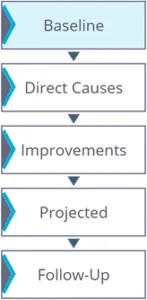Most organizations trying to implement an ergonomics program can build a strong ergonomics team, but often leave other groups in the organization in the dark until they’re called to contribute.
Utilizing an improvement process is universal to most disciplines—quality, equipment, innovation, design all follow the Plan, Do, Check, Act (PDCA) cycle.
The job improvement process for ergonomics is no different.
If groups in an organization don’t cohesively participate in this process, it can lead to the misuse of resources and misalignment between groups. Ultimately, it’ll make reducing risk more difficult and inefficient, preventing the growth and maturity of your ergonomics program. Even worse, your program will eventually contract and decay.
All participating groups should understand the improvement process for the jobs being evaluated. While every organization is different, there are generally 6 teams collaborating to reduce risk, each focusing on the functions of their jobs:
- Ergonomics
- Engineers
- Maintenance
- Product/process designers
- Management
- Executive leadership
The job improvement process breaks down like this:

Baseline Analysis: Mainly powered by your ergo team, but all groups should be familiar with assessment tools and their outputs.
Direct Causes: Ergo team leads in identifying direct causes; engineers support by better defining each cause and tracing those back to root causes.
Improvements: Ergo team needs support from other participating teams to implement meaningful improvements that accurately target direct causes; understanding budget, feasibility, job details and parameters, and gaining approval from executive leadership.
Projected: All groups contribute to measuring impact of improvements to choose appropriate path for getting the most out of investment for reducing risk.
Follow up: Verify effectiveness of changes, quantify risk reduction, and visualize impact of all activities that encompass the job improvement process. Also identify similar jobs that can benefit from the improvements and build momentum for the ergonomics program, resulting in additional growth and maturity.
The value of understanding the job improvement process and collaborating with all groups is key to building a successful ergonomics program.
Whether you are implementing a new program or revitalizing a decaying program, the job improvement process will be paramount to the success of your program, and achieving your overall vision.
Want more info on analysis and job improvements? Check out these posts:
